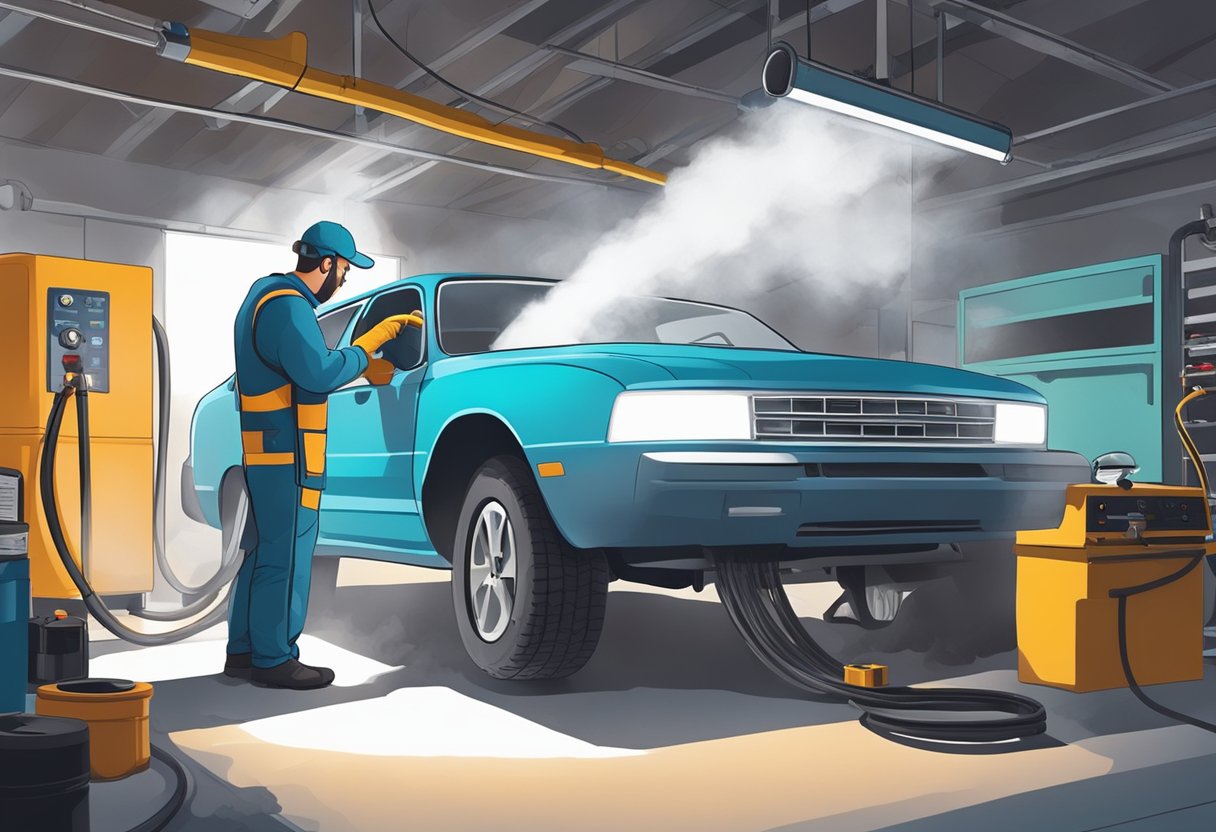If you’ve recently had your check engine light come on and received a P0455 code, you may be wondering what it means and how to fix it.
This code indicates that there is a large evaporative emission system leak, which can cause issues with your vehicle’s performance and emissions.
Fortunately, there are a few tips and tricks you can use to solve the P0455 code and get your car back in top shape.
One of the first things you should do when you receive a P0455 code is check your gas cap.
A loose or damaged gas cap can cause an evaporative emissions leak, and tightening or replacing the cap may solve the problem.
If the gas cap isn’t the issue, you may need to take a closer look at the other components of your vehicle’s evaporative emission system, such as the charcoal canister, purge valve, or fuel tank.
By following a few simple steps and using the right tools, you can diagnose and fix the problem quickly and efficiently.
Understanding the P0455 Code
When your car’s check engine light comes on, it can be a cause for concern.
One of the most common codes that can trigger the light is the P0455 code, which indicates a large evaporative emission system leak.
This code can be caused by a variety of factors, including a loose gas cap, a damaged fuel tank, or a faulty evaporative emission control system.
The evaporative emission control system is responsible for capturing and storing fuel vapors that would otherwise be released into the atmosphere.
The system consists of a network of hoses, valves, and sensors that work together to ensure that the fuel vapors are safely contained and then burned off in the engine.
When there is a leak in the system, the P0455 code is triggered.
One of the most common causes of the P0455 code is a loose or damaged gas cap.
If the gas cap is not tightened properly, it can allow fuel vapors to escape from the tank, triggering the code.
Similarly, a damaged gas cap can also cause a leak in the system.
In some cases, the gas cap may need to be replaced in order to resolve the issue.
Another possible cause of the P0455 code is a damaged fuel tank.
Over time, the fuel tank can become corroded or damaged, leading to leaks in the system.
If this is the case, the fuel tank may need to be replaced in order to fix the problem.
In some cases, the P0455 code may be caused by a faulty evaporative emission control system.
This can be more difficult to diagnose and fix, as it may require replacing or repairing various components of the system.
A qualified mechanic will be able to diagnose the issue and recommend the appropriate course of action.
Overall, it is important to address the P0455 code as soon as possible in order to avoid further damage to your vehicle and to ensure that you are not releasing harmful emissions into the environment.
By understanding the possible causes of the code and taking the appropriate steps to fix the issue, you can keep your car running smoothly and safely.
Common Causes of the P0455 Code
If your vehicle’s check engine light is on and you have received a P0455 code, it means that there is a large evaporative emission system leak.
This code can be caused by several factors, including:
Faulty Gas Cap
The most common cause of a P0455 code is a faulty gas cap.
A gas cap that is not properly tightened or is damaged can cause fuel vapors to escape from the fuel tank, triggering the code.
To fix this issue, simply make sure that the gas cap is tightened securely and is not damaged.
If the gas cap is damaged, it should be replaced.
Leaking EVAP Hoses
Another common cause of a P0455 code is leaking EVAP hoses.
The EVAP system is designed to capture and store fuel vapors, but if there is a leak in one of the hoses, the vapors can escape and trigger the code.
Inspect all of the EVAP hoses for cracks, holes, or other damage.
If any damage is found, the affected hose should be replaced.
Malfunctioning Purge Valve
The purge valve is responsible for controlling the flow of fuel vapors from the EVAP system to the engine.
If the purge valve is not functioning properly, fuel vapors can escape and trigger the P0455 code.
To diagnose this issue, a mechanic will need to inspect the purge valve and test its functionality.
If the valve is found to be faulty, it should be replaced.
Defective Charcoal Canister
The charcoal canister is a component of the EVAP system that is responsible for storing fuel vapors.
If the canister becomes saturated with fuel, it can no longer store vapors and will need to be replaced.
A defective charcoal canister can also cause a P0455 code to be triggered.
A mechanic can diagnose this issue by inspecting the canister and testing its functionality.
Overall, a P0455 code can be caused by a variety of factors, including a faulty gas cap, leaking EVAP hoses, malfunctioning purge valve, or defective charcoal canister.
By identifying and addressing the root cause of the issue, you can clear the code and ensure that your vehicle is running smoothly.
Diagnostic Steps
When dealing with a P0455 code, there are a few diagnostic steps you can take to identify the cause of the problem.
Here are the three main steps to follow:
Visual Inspection
The first step is to perform a visual inspection of the entire evaporative emission system.
Look for any signs of damage or wear, such as cracks, holes, or loose connections.
Check the fuel filler cap and make sure it is tight and in good condition.
Inspect the charcoal canister for any signs of damage or leaks.
Also, check the hoses and lines for any signs of wear or damage.
Smoke Test
If the visual inspection doesn’t reveal any obvious issues, the next step is to perform a smoke test.
This involves introducing smoke into the evaporative emission system and looking for any leaks.
A smoke machine is typically used for this test.
The smoke will flow through the system and reveal any leaks.
This is a quick and effective way to identify the source of the problem.
Electronic Diagnostics
If the previous steps don’t reveal any issues, the next step is to perform electronic diagnostics.
This involves using a scan tool to read the diagnostic trouble codes (DTCs) and view live data from the system.
The scan tool can also perform tests on the system components to identify any issues.
This step can be more time-consuming and may require specialized equipment, but it can be very effective in identifying the root cause of the problem.
By following these diagnostic steps, you can quickly and accurately identify the cause of a P0455 code and take the necessary steps to fix the problem.
Repair and Replacement
If you have identified a large evaporative emission system leak and have already checked the gas cap, it’s time to move on to repairing or replacing the faulty components.
Here are some tips to help you fix the issue:
Gas Cap Replacement
If the gas cap is damaged, missing, or not sealing properly, it can cause a P0455 code.
In this case, you should replace the gas cap with a new one that is compatible with your vehicle’s make and model.
Make sure the new gas cap is tightened properly according to the manufacturer’s specifications.
A loose gas cap can trigger the same code and cause the check engine light to come back on.
EVAP System Repair
The evaporative emission system is a complex network of hoses, valves, and sensors that can develop leaks over time.
To repair the EVAP system, you may need to replace damaged hoses, valves, or other components.
A smoke machine can be used to help locate the leak.
The machine pumps smoke into the system and allows you to see where the smoke is escaping.
Purge Valve Replacement
The purge valve is responsible for regulating the flow of fuel vapor from the EVAP system to the engine.
If the valve is stuck open or closed, it can cause a P0455 code.
To replace the purge valve, you will need to locate it in your vehicle’s engine compartment.
Refer to your owner’s manual or a repair manual for the exact location.
Once you have found the valve, disconnect the electrical connector and remove the mounting bolts.
Install the new valve and reconnect the electrical connector.
By following these tips, you can effectively repair or replace the components responsible for a large evaporative emission system leak and clear the P0455 code.
Preventive Measures and Tips
To avoid encountering the P0455 code, there are some preventive measures and tips you can follow.
Here are some of them:
-
Regularly inspect your fuel cap: A loose or damaged fuel cap is one of the most common causes of the P0455 code.
Make sure your fuel cap is tightened properly and is not damaged or cracked.
If it is, replace it immediately.
-
Check your hoses and lines: Inspect your hoses and lines for any signs of wear, cracks, or leaks.
Replace any damaged hoses or lines immediately.
-
Don’t overfill your tank: Overfilling your tank can cause fuel to spill into the evaporative emissions system, which can trigger the P0455 code.
Only fill your tank to the recommended level.
-
Keep your engine in good condition: A poorly maintained engine can cause the P0455 code to appear.
Follow your vehicle’s recommended maintenance schedule to keep your engine running smoothly.
-
Use high-quality fuel: Low-quality fuel can cause deposits to build up in your fuel system, which can lead to leaks.
Use high-quality fuel to prevent this from happening.
By following these preventive measures and tips, you can reduce the risk of encountering the P0455 code.
However, if you do encounter the code, it’s important to address it as soon as possible to prevent further damage to your vehicle.
As an Amazon Associate we earn from qualifying purchases.

